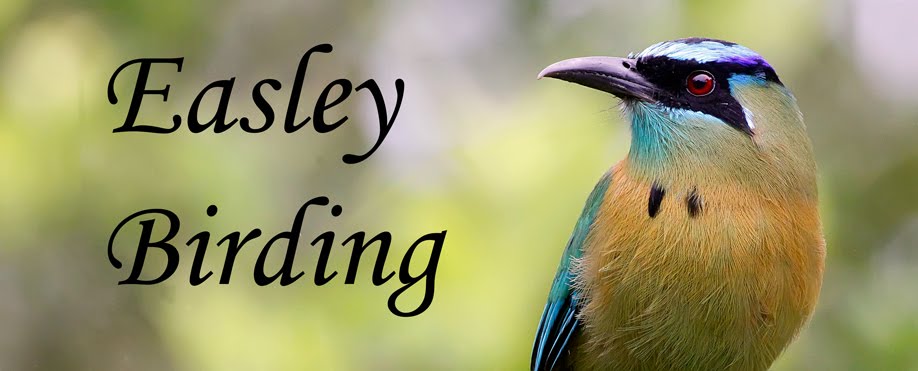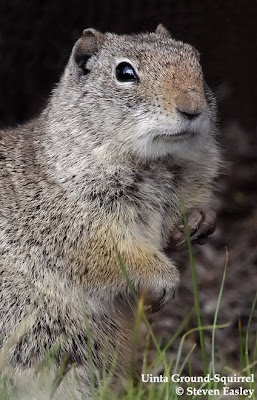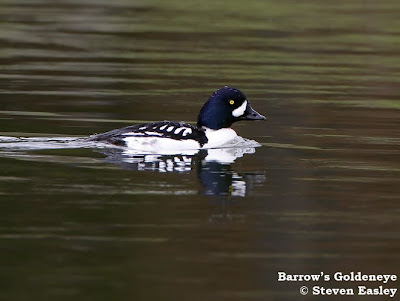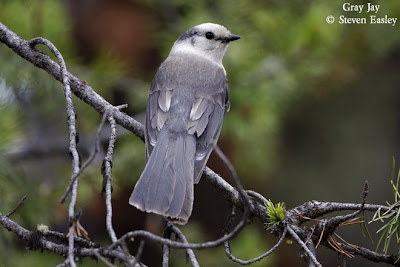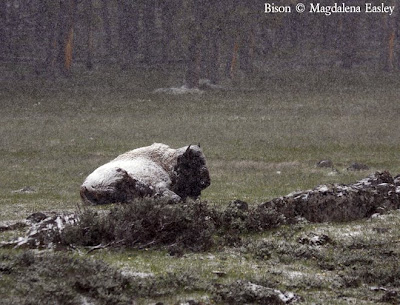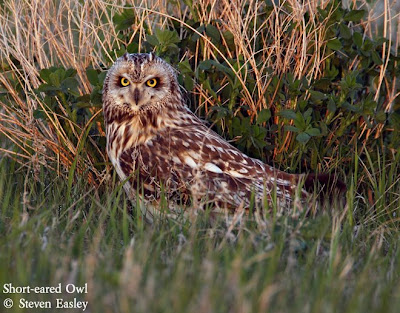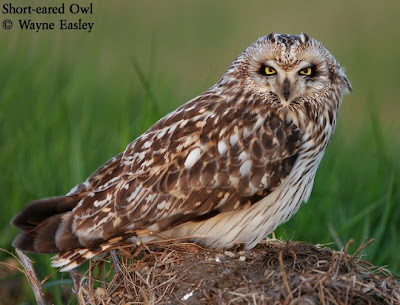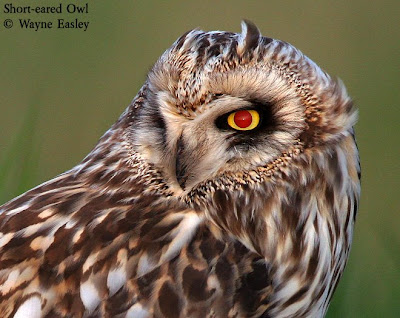



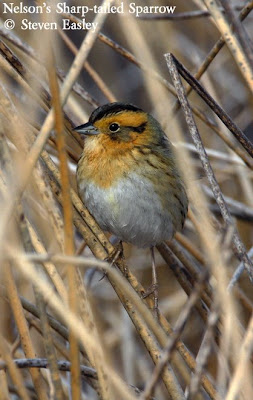
May 27, 2008
Hello Friends,
We returned yesterday evening from a fantastic trip up to the NW corner of North Dakota.
Our goal was to see and photograph as many of the North Dakota speciality birds as possible. We were very successful in not only finding but getting excellent photos of our target species. The only bird we never managed to photograph was the Sprague's Pipit. We saw at least six individuals on the trip, but never managed to get close enough to snap a shot. However, it was quite impressive watching their singing display flight from several hundred feet above the short-grass prairie.
Our first stop was in the J. Clarke Sawyer NWR near Minot. During our tour on the Auto-Loop we encountered several great birds. The highlight was a gorgeous Le Conte's Sparrow singing from a thick reedy patch near the road. Within minutes we were photographing this tiny sparrow at point blank range. What a little stunner! Soon after our magical encounter with the Le Conte's, we found a very aggressive pair of Virginia Rails. They ran straight out of their reed-bed home and began calling from nearly 10 ft away. I actually had to back up in order to focus on these little skulking jewels. Next we tried our luck with the Sprague's Pipit, but like I mentioned above, it was quite tough! Later we made our way further to the northwest for the night.
After spending the night in the quiet little town of Kenmare, we made our way to the Lostwood NWR. The weather was bone chilling cold, and we were thinking that this day was going to be tough. However it turned out to be very productive. The wide open prairie habitat of Lostwood, dotted with small pothole lakes, is quite possibly the best place on the planet to see the local Baird's Sparrow. This target bird was very easy to find and the photos show how close he actually was. We saw at least 4 different individuals and heard several more. We were able to get, quite possibly, our best photos ever of this amazing bird. Our next target also proved easy to locate, the colorful Nelson's Sharp-tailed Sparrow. We found a pair feeding in a small reed-bed just next to the road. It was quite difficult getting suitable photos, but eventually one popped into the open for a couple of shots. Soon after we found the endangered Piping Plover feeding with several peeps. The Piping Plover is certainly a bird that North Dakota folks should be proud of - What a Bird!!!
On our way back towards Harvey, we stopped briefly at the Denbigh Forest near Minot. Our target here was the very strange Red Crossbill. Within minutes we were watching 4 of these bizarre birds feeding just above our heads. What a way to end this short, yet productive trip to some of the prettiest habitat in North America. Long live the American Prairie!!!
My wife finished the trip with 5 lifers - Le Conte's Sparrow, Nelson's Sharp-tailed Sparrow, Baird's Sparrow, Greater White-fronted Goose (with a broken wing) and the feeding party of Red Crossbills.
Good Birding, STEVEN EASLEY
Here is our full trip list from the dates of May 25 & 26, 2008 -
Eared Grebe, Pied-billed Grebe, Western Grebe, Double-crested Cormorant, American Bittern, Black-crowned Night-Heron, Canada Goose, Greater White-fronted Goose, Mallard, Northern Pintail, Gadwall, American Wigeon, Northern Shoveler, Blue-winged Teal, Green-winged Teal, Wood Duck, Canvasback, Redhead, Lesser Scaup, Ruddy Duck, Hooded Merganser, Bufflehead, Bald Eagle, Turkey Vulture, Cooper's Hawk, Sharp-shinned Hawk, Northern Harrier, Red-tailed Hawk, Swainson's Hawk, Ferruginous Hawk, American Kestrel, Prairie Falcon, Ring-necked Pheasant, Gray Partridge, Sharp-tailed Grouse, Wild Turkey, Virginia Rail, Sora, American Coot, Semipalmated Plover, Piping Plover, Killdeer, American Avocet, Greater Yellowlegs, Lesser Yellowlegs, Spotted Sandpiper, Willet, Upland Sandpiper, Marbled Godwit, Ruddy Turnstone, Semipalmated Sandpiper, Least Sandpiper, White-rumped Sandpiper, Baird's Sandpiper, Sanderling, Pectoral Sandpiper, Dunlin, Stilt Sandpiper, Wilson's Phalarope, Red-necked Phalarope, Short-billed Dowitcher, Wilson's Snipe, Ring-billed Gull, Franklin's Gull, Black Tern, Forster's Tern, Mourning Dove, Rock Dove, Great Horned Owl, Chimney Swift, Ruby-throated Hummingbird, Belted Kingfisher, Downy Woodpecker, Hairy Woodpecker, Northern Flicker, Yellow-bellied Sapsucker, Eastern Wood-Pewee, Willow Flycatcher, Alder Flycatcher, Least Flycatcher, Eastern Phoebe, Great Crested Flycatcher, Western Kingbird, Eastern Kingbird, Red-eyed Vireo, Warbling Vireo, Blue Jay, American Crow, American Magpie, Horned Lark, Purple Martin, Tree Swallow, Northern Rough-winged Swallow, Cliff Swallow, Bank Swallow, Barn Swallow, Black-capped Chickadee, Red-breasted Nuthatch, White-breasted Nuthatch, House Wren, Sedge Wren, Marsh Wren, Mountain Bluebird, Eastern Bluebird, Ruby-crowned Kinglet, American Robin, Swainson's Thrush, Veery, Gray Catbird, Brown Thrasher, European Starling, Sprague's Pipit, Cedar Waxwing, Yellow Warbler, Magnolia Warbler, Chestnut-sided Warbler, Yellow-rumped Warbler, Palm Warbler, Blackpoll Warbler, Black-and-white Warbler, American Redstart, Tennessee Warbler, Nashville Warbler, Ovenbird, Northern Waterthrush, Mourning Warbler, Wilson's Warbler, Common Yellowthroat, Rose-breasted Grosbeak, Clay-colored Sparrow, Chipping Sparrow, Baird's Sparrow, Grasshopper Sparrow, Le Conte's Sparrow, Nelson's Sharp-tailed Sparrow, Savannah Sparrow, Vesper Sparrow, Lark Sparrow, Harris's Sparrow, Song Sparrow, Lark Bunting, Chestnut-collared Longspur, Western Meadowlark, Bobolink, Brown-headed Cowbird, Yellow-headed Blackbird, Red-winged Blackbird, Brewer's Blackbird, Common Grackle, Baltimore Oriole, House Finch, American Goldfinch, Pine Siskin, Red Crossbill, House Sparrow




